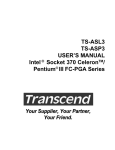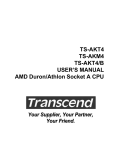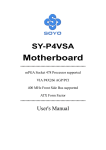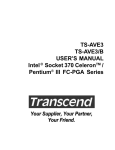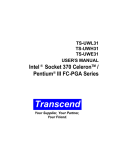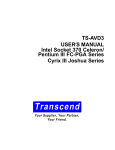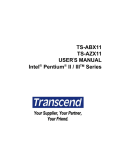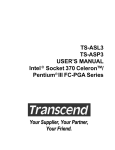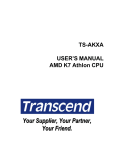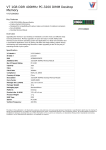Download TS-APR3 USER`S MANUAL Intel®Socket 370
Transcript
TS-APR3 USER’S MANUAL Intel® Socket 370 CeleronTM/ Pentium® III FC-PGA Series TS-APR3 Motherboard Supporting Intel® Socket 370 CeleronTM/Pentium IIITM FC-PGA Series Processor 66/100/133 MHz Front Side Bus Frequency AGP 4X ® VIA PRO 266 Chipset Welcome! Congratulations on your purchase of this great value motherboard with its range of special features and innovative onboard functions built around the advanced architecture of the new VIA® PRO 266 Chipset. More details will follow later in this manual. Our Website Please come visit our website at http://www.transcendusa.com/. You’ll find plenty of interesting information about this and many other quality Transcend products. Your User’s Manual This User’s Manual is designed to help end users and system manufacturers to setup and install the motherboard. All of the information within has been carefully checked for accuracy. However, Transcend Information, Inc. (hereinafter referred to as “Transcend”) bears no responsibility or liability for any errors or inaccuracies, which this manual may contain. This includes references to products and software. In addition, the information and specifications are subject to change without prior notice. Disclaimer Transcend provides this manual “as is” without any warranty of any kind, either expressed or implied, including, but not limited to, conditions of merchantability or fitness for a particular purpose. Transcend, its management, employees, distributors and agents are free of liability for any indirect, special, incidental, or consequential damages including loss of profits, loss of business, etc. This freedom from liability remains in effect even if Transcend has been advised of the possibility of such damages arising from any defect or error in this manual or product. Trademarks All brands, product names, and trademarks mentioned in this document are the property of their respective owners or companies and are used solely for identification or explanation. It is Transcend policy to respect all product rights. Copyright This manual may not, in whole or in part, be photocopied, reproduced, transcribed, translated, or transmitted in any form or language without the prior written consent of the manufacturer, except for copies retained by the purchaser for personal archiving purposes. Manual Version: 1.0 Release Date: March 2001 Copyright © 2001 Transcend Information, Inc. ezBIOS—Motherboard Shield and Upgrade Utility ezBIOS—One Click is All it Takes! Transcend is proud to inform you that your new motherboard comes with ezBIOS from Transcend. This BIOS updating program developed by Transcend will make BIOS updating easy, and enhance the security and stability of systems built with your Transcend motherboard. ezBIOS Features: • Anti-Virus BIOS Protection – Transcend’s motherboards come with a new hardware monitoring function that can prevent any unauthorized BIOS updating caused by viruses. Only ezBIOS, the BIOS updating program developed by Transcend, can update a Transcend motherboard. • BIOS Updating Confidence – Beyond preventing viruses, ezBIOS allows BIOS updating with confidence. In the past, any failure or incorrect operation during BIOS updating could crash the whole system. Normally the user wouldn’t have the capability to retrieve and reestablish the system, they could only return the computer to the supplier for costly, time-consuming repairs. With the enhanced security of ezBIOS, Transcend’s motherboards can completely avoid these problems. No matter what happens during BIOS updating, the user’s system can still boot from the floppy drive, allowing the updating command to be executed again. • One-Click, On-Line BIOS Updating – For users of Windows 95/98, ezBIOS allows you to use Transcend’s innovative on-line updating technology. Just one click can detect the BIOS version of your system, download the latest version, and execute all the updating commands automatically from the Internet. Restarting the computer completes the BIOS updating. This feature should be very handy for users who need to update BIOS repeatedly, especially MIS staff. The on-line updating program is included on the drivers CD-ROM included in the box with your motherboard. Following the step-by-step instructions, you can easily update or backup your BIOS. (If you have a different OS, see “Chapter 4 BIOS Upgrade” for your BIOS updating procedure.) • Linear Overclocking – ezBIOS also provides a linear overclocking function. Users can fine-tune the Front Side Bus (FSB) by increasing or reducing it by as little as 1.0MHz to find the optimum FSB setting for the system. (For details see “Frequency/ Voltage Control” in Chapter 3.) Should the FSB be set too high, the system can be returned to the default setting by pressing the “INS” key. Table of Contents CHAPTER 1 INTRODUCTION 1 1.1 Essential Handling Precautions .......................................................................... 1 1.2 Checklist: Hardware Required for Setup........................................................... 2 1.3 Package Contents ............................................................................................. 3 1.4 Specifications and Features ............................................................................... 3 CHAPTER 2 HARDWARE INSTALLATION 5 2.1 Transcend TS-APR3 Motherboard ..................................................................... 5 2.2 Layout of Transcend TS-APR3 Motherboard ..................................................... 6 2.3 CPU Installation ................................................................................................. 7 2.4 66/100/133MHz System Configuration ............................................................... 9 2.5 Memory Configuration ...................................................................................... 10 2.6 Primary/Secondary IDE Connectors ................................................................ 11 2.7 Floppy Disk Drive Connector ........................................................................... 12 2.8 Fan Power Connectors .................................................................................... 12 2.9 Wake-on-LAN Connector ................................................................................. 13 2.10 Wake-on-Modem Connector ............................................................................ 13 2.11 IrDA-Compliant Infrared Module Connector ..................................................... 14 2.12 Panel Connectors ............................................................................................ 14 2.13 Power Connector ............................................................................................. 16 2.14 External Back Panel I/O Ports ......................................................................... 16 2.15 Clear CMOS Jumper ....................................................................................... 18 2.16 Onboard Audio Setting .................................................................................... 18 2.17 Internal Audio Connector ................................................................................. 19 2.18 Internal USB Port Connector............................................................................ 20 2.19 Suspend To RAM Setting ................................................................................. 21 CHAPTER 3 BIOS SETUP 22 3.1 BIOS Setup ........................................................................................................22 3.2 The Main Menu ...................................................................................................22 3.3 Standard CMOS Features ..................................................................................24 3.4 Advanced BIOS Features ...................................................................................27 3.5 Advanced Chipset Features ...............................................................................31 3.6 Integrated Peripherals........................................................................................ 36 3.7 Power Management Setup................................................................................. 42 3.8 PnP/PCI Configuration Setup ............................................................................. 46 3.9 PC Health Status ................................................................................................ 48 3.10 Frequency/Voltage Control ................................................................................. 49 3.11 Load Fail-Safe Defaults ..................................................................................... 50 3.12 Load Optimized Defaults .................................................................................... 50 3.13 Supervisor Password ......................................................................................... 51 3.14 User Password .................................................................................................. 52 3.15 Save & Exit Setup .............................................................................................. 53 3.16 Exit Without Saving ............................................................................................ 53 CHAPTER 4 BIOS UPGRADE ... 54 4.1 How to Check Your BIOS File Name and Version .............................................. 54 4.2 Download the Correct BIOS File from Our Web Site ......................................... 54 4.3 How to Upgrade Your Motherboard BIOS .......................................................... 55 INTRODUCTION 1 CHAPTER 1 INTRODUCTION 1.1 Essential Handling Precautions IMPORTANT. Read this section before unpacking your motherboard! • Power Supply Be careful! Always ensure that the computer is disconnected from the power supply when working on the motherboard and its components. Near the battery on the motherboard are 2 LEDs. One is green and indicates that the power connector is attached and the system is in Standby, with 5V of power active to the motherboard. The other is red and indicates that the system is fully active and powered. Serious damage could occur if you remove or install any components when the green LED is lit; while additionally, you could experience a nasty shock if you touch anything inside the case when the red LED is lit. • Static Electricity Static electricity may cause damage to the delicate integrated circuit chips on your motherboard. Before handling the motherboard outside of its protective packaging, ensure that there is no static electric charge in your body. A static discharge strong enough to damage computer components is not perceptible by a human. Observe these precautions while handling the motherboard and other computer components: 1. If possible, wear an anti-static wrist strap connected to a natural earth ground. 2. Touch a grounded or anti-static surface, or a metal fixture such as a pipe or the chassis of your system, before touching the motherboard. 3. When you have removed the motherboard from its anti-static packaging, try to hold it only by the edges, without touching any components. 4. Avoid contacting the components on add-on cards, motherboards, and modules with the gold-colored connectors which plug into the expansion slots. 5. Handle system components only by their mounting brackets. 6. Keep components which are not connected to the system in their anti-static packaging whenever possible. INTRODUCTION • Battery Replacement The battery which holds the system settings memory (CMOS RAM) on your motherboard should not require replacement for at least five years, and probably much longer. In picture 2.2, it is located near the lower edge of the motherboard. Incorrect computer time and/or loss of time may indicate a weak motherboard battery. Please replace your battery only with the same type, or a similar type recommended by the battery manufacturer. If the battery is replaced incorrectly, there is a risk of a short circuit or explosion. Used batteries should be disposed of in accordance with the manufacturer’s instructions and local environmental regulations. • Electric Screwdrivers To reduce the risk of damage to the motherboard due to excessive torque, avoid setting electric screwdrivers above 7.5 kg/cm. 1.2 Checklist: Hardware Required for Setup It is advisable to have all of these items of hardware available before you unpack your motherboard from its anti-static packaging and start building your system. - Computer case and chassis with appropriate power supply - Monitor - Socket 370 Central Processing Unit (CPU) and CPU fan - DIMM memory module(s) - PS/2 or USB Keyboard - PS/2 or USB Mouse - Hard Disk Drive - Floppy Disk Drive - CD-ROM Drive - (Optional) External Peripherals: printer, speakers, plotter, modem - (Optional) Internal Peripherals: modem, LAN cards 2 INTRODUCTION 3 1.3 Package Contents This motherboard package should contain the following items. Please check them as soon as you unpack. If you find any damaged or missing items, please contact your retailer. - TS-APR3 motherboard - 1 x CD-ROM - 1 x FDD cable - 1 x Ultra DMA/66/100 cable - User’s Manual - 2 x External USB connectors (Optional) 1.4 Specifications and Features • CPU - Supports Intel® Socket 370 CeleronTM Series - Supports Intel® Pentium III FC-PGA Series • Chipset - VIA VT8633+VT8233 • DRAM Memory - Supports DDR Memory - 3 x 184pin DIMM module slots on board - 8MB~3GB memory size - 8/16/32/64/128/256/512MB DDR DRAM - 64 data bits structure only - PC1600/PC2100 DDR DRAM • I/O BUS Slot - 1 x AGP slot - 5 x Master/Slave PCI slots (PCI 2.2 compliant) - 1 x ACR (Advanced Communication Riser) slot INTRODUCTION • I/O Functions - Supports PIO Mode 3, 4 ATAPI devices and Ultra DMA 33/66/100 EIDE - Supports 2 high speed UART 16550 COM ports - Supports SPP/EPP/ECP LPT port - Supports 1.44/2.88 MB floppy drive - Supports PS/2 Mouse and PS/2 Keyboard - Supports IrDA port - Supports 6 Universal Serial Bus (USB) ports - Supports Line-out, Line-in, and MIC-in jacks. - Supports Game/MIDI port • Build-in AC97 CODEC - AC97 2.1 Compliant • Award BIOS - Supports Plug-and-Play, PC99 - Supports ACPI, APM, DMI and Green Feature • Wakeup Features - Supports Wake-on-LAN function - Remote Ring Wakeup - Time Wakeup • Switching Voltage Regulator - Intel® VRM 8.4 compliant • Other Features - Year 2000 compliant - Anti-Virus Boot up - System voltage monitors for CPU Vcore, VTT, +3.3V, +5V and +12V, -12V, -5V, VBAT(V) and 5VSB(V) - CPU temperature monitor - System temperature monitor - FAN speed monitor • PCB Dimensions - ATX form factor, 4-layer PCB, 22 cm x 30.5 cm (8.7 inch x 12 inch) 4 HARDWARE INSTALLATION 5 CHAPTER 2 HARDWARE INSTALLATION 2.1 Transcend TS-APR3 Motherboard I/O Port CPU ·GAME/MIDI Port & Audio Jack (Line-In, Line-Out, MIC-In) · 2 x COM Port & 1 x Parallel Port ·2 x USB Ports · PS/2 KB Port & PS/2 Mouse Port · Intel Celeron TM Socket 370 CPU 300A~733 MHz (FSB 66 MHz) ·Inte l ® Pentium ® III Socket 370 FC-PGA CPU 533A~1130+ MHz (FSB 100/133 MHz) ® Memory · 3 x 184pin DIMM Sockets · 8MB~3GB DDR Nouth Bridge FDD Connector AGP Connector · AGP 4X/2X PCI IDE Connector · Bus Master · PIO Mode 3/4 · DMA Mode 2 · Ultra DMA 33/66/100 AC97 CODEC · AC97 Audio CODEC South Bridge USB Connector · 4 x USB Ports Flash EEPROM · Award BIOS · PnP,DMI · ACPI compliant Expansion Slots IrDA · 5 x PCI Slots ·1 x ACR Slot WOM Header · Wake-on-Modem WOL Header · Wake-on-LAN Power LEDs HARDWARE INSTALLATION 6 2.2 Layout of Transcend TS-APR3 Motherboard KB MOUSE PS/2 T:Mouse B:Keyboard CPU-FAN PGA 370 Nouth Bridge FDD Game / MIDI Port COMB Power Connector COMA DIMM3 (184pin DDR Module) DIMM1 (184pin DDR Module) T:USB 1 B:USB 2 DIMM2 (184pin DDR Module) USB SW3 AUX AGP Slot JP3 ACR CD2 JP2 PCI Slot 1 CD1 JUSB1 PCI Slot 2 VIDEO South Bridge JUSB2 MODEM IDE1 IDE2 PCI Slot 3 Transcend PCI Slot 4 TS-APR3 CNX1 IRDA SYS-FAN WOM JP1 JP4 Lithium Battery PCI Slot 5 WOL SYS-FAN2 Panel Connector HARDWARE INSTALLATION 7 2.3 CPU (Central Processing Unit) Installation All this point you should be familiar with the handling precautions; checked that you have all of the necessary hardware for building your system; inspected the motherboard package contents; and, looked at the layout of the motherboard. This chapter will take you step-by-step through the process of installing the different hardware devices onto your new Transcend motherboard. Caution! 1. Remember to always make sure the system power is off before installing or removing any devices. Check the Power Indicator LEDs near the lower edge of the motherboard as shown in Fig. 2.1 and 2.2 and described in Section 1.1. 2. Don’t forget the static electricity precautions. (See Section 1.1.) 3. Be careful! Incorrectly inserting hardware onto your motherboard can permanently damage the motherboard. The motherboard has a ZIF Socket 370 to house the CPU. A CPU fan is necessary to prevent overheating. If no fan has been supplied with the CPU, purchase and install one before you turn on your system. Warning! CPUs generate tremendous heat while operating. Make sure to install a CPU fan with enough heat-dissipation grease to cover the CPU die before powering up the computer. Never run the processor without the heatsink properly and firmly attached. PERMANENT DAMAGE COULD RESULT! Please follow the steps below to install the CPU: Step 1: To install the CPU, first turn off your system and remove its cover. Locate the ZIF socket and open it by first pulling the lever sideways away from the socket then upwards at a 90-degree right angle. Insert the CPU in the correct direction, smear the heat-dissipation grease over the CPU die, then put a CPU fan on to cover the face of the CPU. With the added weight of the CPU HARDWARE INSTALLATION 8 fan, no force is required to insert the CPU into the socket. Once completely inserted, close the socket’s lever while holding down the CPU. This locks the CPU into the socket. Step 2: Connect the CPU fan’s cable to the CPU-FAN connector indicated on the diagram below. Ensure that the cable is connected correctly! It will be obvious which way it must fit. CPU-FAN Transcend Socket 370 CPU (BottomView) Notch Notch Socket 370 CPU (Top View) Socket 370 CPU Installation 9 HARDWARE INSTALLATION 2.4 66/100/133 MHz System Configuration SW3 allows you to set the FSB (Front Side Bus) for 66, 100, or 133 MHz Configuration. SW3 Transcend SW3 1 2 66 o o 100 x o 133 x x O: ON X: OFF 66/100/133 MHz FSB Configuration Jumper 3 4 o o x o x x HARDWARE INSTALLATION 10 2.5 Memory Configuration This motherboard must be installed with DIMMs (Dual Inline Memory Modules). The DIMMs must be 2.5V DDR DRAM modules. The VIA PRO 266 chipset supports PC1600, PC2100. You can install memory in any combination as follows: DIMM Location 184pin DIMM DIMM1 DDR DRAM 8,16, 32, 64,128, 256, 512 MBytes DIMM2 DDR DRAM 8,16, 32, 64,128, 256, 512 MBytes DIMM3 DDR DRAM 8,16, 32, 64,128, 256, 512 MBytes Total Memory 3 GBytes (max.) NOTE: Different types of DRAM modules suggested not to be installed on one motherboard at the same time. Transcend 184Pin DDR DRAM Module (DIMM1) 184Pin DDR DRAM Module (DIMM2) 184Pin DDR DRAM Module (DIMM3) 184Pin DDR DIMM Sockets HARDWARE INSTALLATION 11 2.6 Primary/Secondary IDE Connectors (Two 40-pin IDE) This mainboard supports two 40-pin IDE connectors marked as IDE1 (primary IDE channel) and IDE2 (secondary IDE channel). Each channel supports two IDE devices, for a total of four devices. Connect your Hard Disk Drive (HDD) (the main one if you are using more than one) to the “Master” connector (at the end of the cable) and connect it to IDE1 (see important note below). If your HDD supports UltraDMA/66/100, you must use an 80-wire cable, otherwise the HDD won’t be able to reach this speed. If you intend to operate two IDE devices from the same channel, one device must be set to “Master” mode, the other to “Slave” mode. Hard disk drives, CD ROM drives and other IDE devices can be set as either “master” or “slave”, depending on the device’s jumper settings. Please refer to the device’s user manual for more information. NOTE: The connectors must be attached properly to the IDE channels. Ensure that the red stripe on one edge of the ribbon cable (this may be faint and could also be a dotted line) is the closest to PIN1 (on the left with the motherboard as oriented in the picture below). Note: Orient the red stripe to PIN1 Transcend Primary IDE Connector IDE2 PIN1 IDE1 PIN1 Secondary IDE Connector IDE Connectors HARDWARE INSTALLATION 12 2.7 Floppy Disk Drive Connector (34-pin FDC) This connector supports the provided floppy disk drive ribbon cable. After connecting the single plug end of this cable to the motherboard, connect the two plugs on the other end to the floppy disk drive. Note: Orient the red stripe to PIN1 Floppy Drive Connector Transcend FDC PIN1 Floppy Disk Drive Connector 2.8 Fan Power Connectors There are three fan power connectors on the motherboard: the CPU-FAN, SYS-FAN and SYSFAN2. Each connector provides +12V power. Make sure the power cables are connected in the right direction or damage may occur. These connectors support cooling fans of 500 mA (6W) or less. CPU-FAN Transcend Fan Power Connectors SYS-FAN GND +12V Rotation SYS-FAN2 GND +12V Rotation 13 HARDWARE INSTALLATION 2.9 Wake-on-LAN Connector (3-pin WOL) This connector connects to LAN cards with a Wake-on-LAN output. The system can be powered up when a wakeup packet or signal is received from the LAN card. NOTE: This function requires that the “LAN Wake Up” function in the POWER MANAGEMENT SETUP is set to “Enabled” and that your system has an ATX power supply with at least 720mA +5V standby power. WOL Transcend +5 Volt Standby GND PME Wake-On-LAN Connector 2.10 Wake-on-Modem Connector (3-pin WOM) This connector allows the system to be powered up upon receipt of a call via the modem. NOTE: This function requires a modem which supports the Ring Wake-Up function and that your system has an ATX power supply with at least 720MA+5V standby power. WOM Transcend Wake-On-Modem Connector +5 Volt Standby GND RI- HARDWARE INSTALLATION 14 2.11 IrDA-Compliant Infrared Module Connector (10-pin IrDA) The IrDA connector can be configured to support a wireless infrared module. With this module and application software such as Laplink or Win95 Direct Cable Connection, the user can transfer files to or from laptops (notebooks), PDAs and printers. IrDA IRTX IRRX GND +5V Transcend 9 10 CIRRX 5VSB IrDA Connector 2.12 Panel Connectors SPEAKER PW_ LED Transcend PIN 11 + P I N 1+ + + HD_LED SLPBTN RST Panel Connectors PIN 20 PIN 10 PW_BN 15 HARDWARE INSTALLATION HD_ LED (2-pin HD_LED) This 2-pin connector connects to the LED of the HDD. The LED lights up when the HDD is active. PIN3: +5V PIN4: GND Sleep Button LED (2-pin SLPBTN) PIN5: SLPBTN PIN6: GND Reset Switch LED (2-pin RST) This 2-pin connector connects to the case-mounted reset switch for rebooting your computer without turning off your power switch. PIN7: RST PIN8: GND Software Power-Off LED (2-pin PW_BN) Attach the PW_BN Switch of the panel to this connector. PIN9: PW_BN PIN10: GND Power LED (3-pin PW_ LED) This 3-pin connector attaches to the power LED. PIN11: +5V PIN12: NC PIN13: GND Speaker (4-pin SPEAKER) This 4-pin connector connects to the case-mounted speaker. PIN17: +5V PIN18: NC PIN19: NC PIN20: SPK HARDWARE INSTALLATION 16 2.13 Power Connector (20-pin PWR-CONN) Make sure to plug the ATX power supply connector in the right direction. The pin definition is shown below. Make sure that your ATX power supply can support at least 720mA on standby. GND Power Good +5.0V Standby +12.0V +5.0V +5.0V GND -5.0V GND GND GND PSON# +3.3V -12.0V +3.3V +3.3V GND Transcend +5.0V GND +5.0V PWR PSON# : Power Supply on Power Connector 2.14 External Back Panel I/O Ports There are 9 kinds of external connectors on the motherboard. The view in the drawing on the next page is the back panel of the motherboard housing. 1. PS/2 Mouse Port (Green, 6-pin MOUSE) The onboard PS/2 Mouse port is a 6-pin Mini-Din connector marked “MOUSE” 2. PS/2 Keyboard Port (Purple, 6-pin KB) The onboard PS/2 Keyboard port is a 6-pin Mini-Din connector marked “KB”. 3. Universal Serial Bus (USB) Ports 1 & 2 (Black, two 4-pin USBs) You can attach USB devices to the two USB ports marked “USB”. (Two additional USB Ports can be added using an optional 2x5 header to the on-board connectors JUSB1 and JUSB2.) 4. Parallel Port (Burgundy, 25-pin PRN) The onboard parallel/printer port is a 25-pin D-type connector marked “PRN”. 17 HARDWARE INSTALLATION 5. Serial Port (Turquoise, one 9-pin COMA) The external back panel serial ports are 9-pin D-type connectors marked as “COMA” and “COMB”. 6. Game Port/MIDI Port (Gold 15-pin GAME) The onboard Game port/MIDI Port is a 15-pin D-type connector marked “GAME”. 7. Line_out (Lime Green 1/8” LINE_OUT) The onboard Line_out connector is a 1/8” stereo audio jack marked “LINE_OUT”. 8. Line_in (Light blue 1/8” LINE_IN) The onboard Line_in connector is a 1/8” stereo audio jack marked “LINE_IN”. 9. MIC_IN (Pink 1/8” MIC_IN) The onboard MIC_in connector is a 1/8” stereo audio jack connector marked “MIC”. 4. Parallel Port (Printer) 1. PS/2 Mouse 7. Game/MIDI Port 3. USB1 3. USB2 2. PS/2 Keyboard 5. COMA 6. COMB 9. Line_in 8. Line_out External Back Panel I/O Ports 10. MIC in HARDWARE INSTALLATION 18 2.15 Clear CMOS Jumper (3-pin JP1) To clear CMOS data, you must turn off system power and short pin2 and pin3 of JP1. JP1 1 Transcend CMOS 1 Normal 1 Clear Clear CMOS Jumper 2.16 Onboard Audio Setting (3-Pin JP2) If you wish to use an external ACR (or AMR) card, the onboard audio CODEC can be enabled or disabled via jumper JP2. Please disable the onboard audio CODEC, if you want to use an ACR (or AMR) Sound Card. NOTE: If you want to use a PCI Sound Card with an audio controller on it, please disable the “OnChip Sound” function in “Advanced Chipset Features”. JP2 1 Transcend Onboard Audio Setting 1 1 Audio Selection Jumper Default Onboard Codec AMR Codec HARDWARE INSTALLATION 19 2.17 Internal Audio Connectors These connectors allow you to receive stereo audio input from sound sources such as a CDROM, TV tuner, or MPEG card. The MODEM connector allows the onboard audio to interface a voice modem card with a matched connector. It also allows the sharing of mono_in (such as a phone) and mono_out (such as a speaker) between the onboard audio and the voice modem card. Right Audio Channel GND Left Audio Channel VIDEO (Green) Transcend Right Audio Channel GND Left Audio Channel AUX (White) Right Audio Channel GND Left Audio Channel CD2 (White) Internal Audio Connectors Right Audio Channel GND Left Audio Channel CD1 (Black) Modem-Out (MOUT) GND Modem-In (PHONE) MODEM (White) HARDWARE INSTALLATION 20 2.18 Internal USB Port Connector (10-Pin JUSB1/2) You can use the optional serial port bracket to add two additional serial ports for additional serial devices. Regarding the external USB ports (USB1 and USB2), please refer to Section 2.14 “External Back Panel I/O Ports”. NOTE: Please make sure that the two red stripes on the cable are seated on PIN1 and PIN2. JUSB1 PIN1 PIN2 VCC Transcend VCC USB2- USB3- USB2+ USB3+ GND GND GND JUSB2 PIN1 Internal JUSB Port Connector PIN2 VCC VCC USB4USB4+ USB5- GND GND USB5+ GND HARDWARE INSTALLATION 21 2.19 Suspend To RAM Setting (3-Pin JP4) To use the STR Function, turn off system power and short pin 2 and 3 of JP4. Reboot the system and enter BIOS Setup to turn on STR. Refer to 3.7 “Power Management Setup” for details. JP4 1 Transcend CMOS 1 SOFT_OFF 1 STR_OFF Suspend To RAM Setting Jumper Congratulations! You have completed Hardware Setup! You may now continue with “Chapter 3 BIOS Setup” and turn on your PC. BIOS SETUP 22 CHAPTER 3 BIOS SETUP 3.1 BIOS Setup Award BIOS has a built-in Setup program that allows users to modify the basic system configuration. This information is stored in CMOS RAM, so it can retain the Setup information when the power is turned off. If the CMOS battery fails, these data will be lost. If that happens, you must setup your configuration parameters again after replacing the battery. Refer to Section 1.1, Essential Handling Precautions (Page 1) for instructions on replacing the CMOS battery. 3.2 The Main Menu As you turn on or reboot the system, the BIOS is immediately activated. It will read the system configuration information, and check the system through the Power On Self Test (POST). During the POST process, press the [Del] key, to enter the Award BIOS Setup configuration system. The following screen will appear: In the Award BIOS system, you can use the arrows ( ) to highlight an item. Pressing the [Enter] key enters the item’s submenu. The following keys help navigate in Setup. [Esc] Main Menu: Quit and do not save changes into CMOS RAM Other pages: Exit current page and return to Main Menu [PgUp] Increase the numeric value or make changes [PgDn] Decrease the numeric value or make changes BIOS SETUP 23 [+] Increase the numeric value or make changes [-] Decrease the numeric value or make changes [F1] General help on setup navigation keys [F5] Load previous values from CMOS [F6] Load the Fail-Safe Defaults from BIOS default table [F7] Load the Optimized Defaults [F10] Save all CMOS changes, and exit The following is a brief summary of each setup category: • Standard CMOS Features Options in the original PC AT-compatible BIOS • Advanced BIOS Features Award enhanced BIOS options • Advanced Chipset Features Available options specific to your system Chipset • Integrated Peripherals I/O subsystems that depend on the integrated peripheral controllers in your system • Power Management Setup Advanced Power Management (APM) and Advanced Configuration and Power Interface (ACPI) options • PnP/PCI Configurations Plug and Play standard and PCI Local Bus configuration options • PC Health Status To display the fan status, CPU temperature, system temperature etc., and to provide the temperature monitoring option • Frequency/Voltage Control To control the frequency and voltage of the CPU • Load Fail-Safe Defaults To load the most basic BIOS default values required for your system to operate • Load Optimized Defaults To load the BIOS default values that are factory settings for optimal system performance BIOS SETUP 24 • Set Supervisor/User Password To change, set, or disable a password • Save & Exit Setup To save settings in nonvolatile CMOS RAM and exit Setup • Exit Without Saving To abandon all changes and exit Setup 3.3 Standard CMOS Features • Date (mm:dd:yy)/Time (hh:mm:ss) Highlight the items and use [PageUp]/[PageDown] to change the value of Date/Time. • IDE Primary/Secondary Master/Slave Press [Enter] to enter the submenu shown below: BIOS SETUP 25 • IDE HDD Auto-Detection: Detect the HDD on this channel. If the detection is successful, it fills the remaining fields on this menu. • IDE Primary/Secondary Master/Slave: We recommend that you select “AUTO” for all drives. The BIOS can automatically detect the specifications during POST (Power On Self Test) while the system boots. You can also choose “Manual” to set the specifications yourself. The “None” setting means there is no device installed on this IDE channel. • Access Mode: “CHS”, “LBA”, “Large”, or “Auto”. - CHS: Maximum number of cylinders, heads, and sectors supported are 1024, 16, and 63 respectively. - LBA (Logical Block Addressing): During drive access, the IDE controller transfers the data address described by sector, head, and cylinder number into a physical block address. This will significantly improve data transfer rates for drives with more than 1024 cylinders. • - Large: For drives that do not support LBA and have more than 1024 cylinders. - Auto: The BIOS automatically determines the optimal access mode. Capacity: Disk drive capacity. Note that this size is slightly greater than the size of a formatted disk given by the disk-checking program. • Cylinder: Number of cylinders • Head: Number of heads • Precomp: Write precompensation cylinder • Landing Zone: Landing zone • Sector: Number of sectors • Drive A/Drive B Select the correct types of diskette drive(s) installed in the computer. - None: No diskette drive installed - 360K, 5.25 in.: 5-1/4 inch standard drive; 360 KB capacity - 1.2M, 5.25 in.: 5-1/4 inch high-density drive; 1.2 MB capacity - 720K, 3.5 in.: 3-1/2 inch double-sided drive; 720 KB capacity - 1.44M, 3.5 in.: 3-1/2 inch double-sided drive; 1.44 MB capacity - 2.88M, 3.5 in.: 3-1/2 inch double-sided drive; 2.88 MB capacity BIOS SETUP 26 • Video Select the type of primary video subsystem in your computer. The BIOS will detect the correct video type automatically. The BIOS supports a secondary video subsystem, but do not select it in this Setup. - EGA/VGA: Enhanced Graphics Adapter/Video Graphics Array. For EGA, VGA, SEGA, SVGA or PGA monitor adapters. - CGA 40: Color Graphics Adapter, powers up in 40-column mode. - CGA 80: Color Graphics Adapter, powers up in 80-column mode. - MONO: Monochrome adapter, including high resolution. • Halt On During POST, the computer stops if the BIOS detects a hardware error. You can set the BIOS to ignore certain errors during POST and continue the boot-up process. The followings are the selections. - All Errors: If the BIOS detects any non-fatal errors, POST stops and prompts you to take corrective action. - No Errors: POST does not stop for any error. - All, But Keyboard: If the BIOS detects any non-fatal errors except keyboard, POST stops and prompts you to take corrective action. - All, But Diskette: If the BIOS detects any non-fatal errors except the diskette drive, POST stops and prompts you to take corrective action. - All, But Disk/Key: If the BIOS detects any non-fatal errors except keyboard or the diskette drive, POST stops and prompts you to take corrective action. BIOS SETUP 27 3.4 Advanced BIOS Features The “Advanced BIOS Features” option allows you to improve your system performance, and setup system features according to your preferences. • Virus Warning When this function is enabled, you will receive a warning message if a program (specifically, a virus) attempts to write to the boot sector or the partition table of the hard disk drive. You should then execute an anti-virus program. Keep in mind that this feature protects the boot sector only, not the entire hard drive. NOTE: Many disk diagnostic programs that access the boot sector table can trigger the virus warning message. If you plan to run such a program, we recommend that you first disable this virus warning. BIOS SETUP 28 • CPU Internal Cache/External Cache Cache memory is additional memory that is much faster than conventional DRAM (system memory). CPUs from 486-type and up contain internal cache memory. Most, but not all, modern PCs have additional (external) cache memory. When the CPU requests data, the system transfers the requested data from the main DRAM into cache memory for even faster access by the CPU. The “External Cache” field may not appear if your system does not have external cache memory. • CPU L2 Cache ECC Checking Select “Enabled” to ensure that the data are accurate. • Processor Number Feature This function was designed with the internet in mind. Select “ Enable” to make the processor serial number serve as a means of identifying your system. • Quick Power On Self Test Select “Enabled” to reduce the amount of time required to run the POST. The Quick POST skips certain steps. We recommend that you normally disable Quick POST. It’s better to find a problem during POST than to lose data during your work. • First/Second/Third Boot Device; Boot Other Device The original IBM PCs loaded the DOS operating system from drive A (floppy disk). Therefore, IBM PC-compatible systems are designed to search for an operating system first on drive A, and then on drive C (hard disk). However, the BIOS attempts to load the operating system from the devices in the sequence selected in these fields. In addition to the traditional drives A (“Floppy”) and C (“HDD-0”), options include “HDD-1”, “HDD-2”, “HDD-3”, and “CD-ROM”; plus a “SCSI” hard drive, a “LS120” drive, a “ZIP100” drive and a “LAN” drive. If your boot device is not included in the list, you can set the “Boot Other Device” field to “Enabled”, and let the system detect the drive automatically. • Swap Floppy Drive This field is effective only in systems with two floppy drives. Selecting “Enabled” assigns physical drive B to logical drive A, and physical drive A to logical drive B. BIOS SETUP 29 • Boot Up Floppy Seek When you select “Enabled”, the BIOS tests (seeks) floppy drives to determine whether they have 40 or 80 tracks. Only 360-KB floppy drives have 40 tracks; drives with 720KB, 1.2MB, and 1.44MB capacity all have 80 tracks. Because very few modern PCs have 40track floppy drives, we recommend that you set this field to “Disabled” to save time. • Boot Up NumLock Status Toggle between “On” and “Off” to control the state of the NumLock key when the system boots. When toggled “On”, the numeric keypad generates numbers instead of controlling cursor operations. • Gate A20 Option Choose “Fast” (default) or “Normal”. “Fast” allows RAM access above 1MB to use the fast Gate A20 line. • Typematic Rate Setting When this function is disabled, the following two items (Typematic Rate and Typematic Delay) are irrelevant. Keystrokes repeat at a rate determined by the keyboard controller in your system. When this function is enabled, you can select a typematic rate and typematic delay. • Typematic Rate (Chars/Sec) When the Typematic Rate setting is enabled, you can select a typematic rate (the rate at which characters repeat) to “6”, “8”, “10”, “12”, “15”, “20”, “24” or “30” characters per second. • Typematic Delay (Msec) When the Typematic Delay setting is enabled, you can select a typematic delay (the delay before key strokes begin to repeat) of “250”, “500”, “750” or “1000” milliseconds. • Security Option If you have set a password, you can select whether the password is required while the system boots, or only when you enter “Setup”. BIOS SETUP 30 • OS Select for DRAM > 64MB Select “OS2” only if you are running the OS/2 operating system with more than 64 MB of RAM on your system. • Video BIOS Shadow Select “Enabled” to change the video BIOS location form ROM to RAM, where the CPU can read data through the 64-bit DRAM bus. This can enhance system performance. 31 BIOS SETUP 3.5 Advanced Chipset Features This option will change the values of the chipset registers and the system settings will alter. Do not change any values if you are unfamiliar with the chipset. • DRAM Clock/Drive Control This submenu allows you to adjust DRAM timing for stability or overclocking. BIOS SETUP 32 • Current FSB Frequency This field will display the current Front Side Bus (FSB) frequency. • DRAM Clock You can select “By SPD” and let BIOS detect the DRAM Clock automatically. You can also set this field to “HCLK+33M” or “ HCLK-33M” if you aren’t very sure that the DRAM can work normally at the frequency you select. The Default value is “HostCLK”. • DRAM Timing This item allows you configure next two items manually. If you aren’t familiar with these features, just leave this field as “By SPD” • SDRAM CAS Latency This controls the SDRAM performance,default is “3” clocks. If your SDRAM DIMM specification is 2 CAS latency, change “3” to “2” for better performance. You may also try setting this value to “2.5.” • Bank Interleave This function allows you to enhance the DRAM performance. Selections are: “Disabled, 2 Bank, and 4 Bank.” • Enhanced DDR Drive The onboard clock generator can enhance the DDR clock driving strengh by 25%. We suggest user leave this field as “Disabled” unless you are sure that a system stability problem is being caused by a heavy load on the DDR DRAM. BIOS SETUP 33 • AGP & P2P Bridge Control This submenu controls the AGP related register settings. • AGP Aperture Size Memory-mapped graphics data structures can reside in a Graphics Aperture. This item lets you determine the effective size of the AGP Graphics Aperture, which is a memory area used to transfer data to/from the AGP card. We suggest you leave this field on the default setting. • AGP Mode This item configures the chipset’s fastest AGP Mode. You can set this field to “2” to force a 4X AGP card to run at 2X speed. • AGP Driving Control This function allows you to adjust the AGP driving force. Choosing ‘Manual’ allows you set the AGP Driving Value in the next field. We recommend that you set this field to “Auto” to avoid any errors in the system settings. • AGP Driving Value This field allows you to adjust the AGP driving force (from OO~FF). • AGP Master 1 WS Write Selecting “Enabled” will implement a single delay when writing to the AGP Bus. By default, two wait states are used by the system, allowing for greater stability. BIOS SETUP 34 • AGP Master 1 WS Read This implements a single delay when reading to the AGP Bus. By default, two-wait states are used by the system, allowing for greater stability. • AGP Fast Write This field allows you to enable AGP Fast Write. • CPU & PCI Bus Control This submenu controls the CPU and PCI Bus controller register. • CPU to PCI Write Buffer If “Enabled” is selected, writes from the CPU to the PCI bus are buffered to compensate for the speed differences between the CPU and the PCI bus. If “Disabled”, the writes are not buffered and the CPU must wait until the write is complete before starting another write cycle. • PCI Master 0 WS Write When “Enabled”, writes to the PCI bus are executed with zero wait states. • PCI Delay Transaction The chipset has an embedded 32-bit posted write buffer to support delay transaction cycles. Selecting “Enabled” supports compliance with PCI specification version 2.1. BIOS SETUP 35 • Memory Hole Enabling this feature reserves memory address space (between 15 and 16MB) to ISA expansion cards that specifically require this setting. This makes between 15 and 16MB of memory unavailable to the system. Expansion cards can only access memory up to 16MB. The default setting is “Disabled”. • System BIOS Cacheable Selecting “Enabled” allows caching of the system BIOS. This action can increase system performance. • Video RAM Cacheable Selecting “Enabled” allows caching of the video BIOS. This action can increase system performance. • Memory Parity/ECC Check When parity DRAM modules are installed, select “Enabled” to correct 1 bit memory errors in the memory. Otherwise, select “Disabled”. BIOS SETUP 3.6 Integrated Peripherals Choose this option and the following display appears: • VIA OnChip IDE Device This submenu configures the OnChip IDE controller. 36 BIOS SETUP 37 • OnChip IDE Channel 0/1 The chipset contains a PCI IDE interface which supports two IDE channels. Select “Enabled” to activate the first and/or second IDE interface. Select “Disabled” to deactivate this interface if you install a primary and/or secondary add-in IDE interface. • IDE Prefetch Mode The Onboard IDE drive interface supports IDE prefetching for faster drive access. If your IDE drive has an add-in IDE interface and doesn’t support prefetching, please set this field to “Disabled”. • Primary/Secondary Master/Slave PIO The four IDE PIO (Programmed Input/Output) fields let you set a PIO mode (0-4) for each of the four IDE devices that the onboard IDE interface supports. Modes 0 through 4 provide successively increased performance. In “Auto” mode, the system automatically determines the best mode for each device. • Primary/Secondary Master/Slave UDMA Ultra DMA33/66/100 implementation is possible only if your IDE hard disk drive (HDD) can support it and the operating environment includes a DMA driver (Windows 95 OSR2 or a third-party IDE bus master driver). If both your HDD and your system software can support Ultra DMA33/66/100, select “Auto” to enable BIOS support. BIOS SETUP 38 • VIA On-Chip PCI Device • VIA AC97 Audio Select “Auto” to enable the OnChip Audio Controller, which lets you use Onboard CODEC or an add-on CODEC card in the ACR slot (depending on the JP2 setting). If you use an add-on Audio Card with an Audio Controller built-in, please set this field to “Disabled”. • VIA MC97 Modem Select “Auto” to enable the OnChip MODEM Controller, which lets you use an add-on MODEM card in the ACR slot. If you use an add-on card with a MODEM Controller builtin, please set this field to “Disabled”. • VIA OnChip LAN Select “Enabled” to use the OnChip LAN Controller, which lets you use an add-on LAN device in the ACR slot. If you don’t use an ACR LAN device, please set this field to “Disabled”. BIOS SETUP 39 • VIA Super IO Device • Onboard FDC Controller You can use this function to enable or disable the onboard FDD controller. • Onboard Serial Port 1/Port 2 Select an address and the corresponding interrupt for each of the first and second serial ports. The Choices are: “Disabled”, “3F8/IRQ4”, “2F8/IRQ3”, “3E8/IRQ4”, “2E8/IRQ3”, and “Auto”. The second serial port shares resources (address and IRQ) with IrDA. • UART Mode Select Choose the right type of infrared device. Selections are: - IrDA: IrDA compliant serial infrared port - ASKIR: Amplitude Shift Keyed Infrared Port - Normal: Standard operation • RxD , TxD Active Consult your IR peripheral’s documentation to set this field. • IR Transmission Delay Consult your IR peripheral’s documentation to set this field. • UR2 Duplex Mode Consult your IR peripheral’s documentation to select the proper setting for your IR device. BIOS SETUP 40 • Use IR Pins Consult your IR peripheral’s documentation to set this field. • Onboard Parallel Port Select a logical LPT port name and matching address for the physical parallel (printer) port. The choices are: “378/IRQ7”, “278/IRQ5”, “3BC/IRQ7” and “Disabled”. • Parallel Port Mode This field allows you to set the operation mode of the parallel port. Selections are: - SPP: Allows normal-speed operation, but in one direction only. - EPP: Allows bidirectional parallel port operation at maximum speed. - ECP: Allows DMA and bidirectional operation. This is faster than EPP mode. - ECP + EPP: Allows normal speed operation in two-way mode. • EPP Mode Select Select EPP port type “EPP1.7” or “EPP1.9”. • ECP Mode Use DMA Assign DMA channel “1” or “3” to the port for ECP mode operation. • Game Port Address Assign Game Port resources. Selections are: “201”, “209”, or “Disabled”. • Midi Port Address Assign Midi Port resources. Selections are: “330”, “300”, “290”, or “Disabled”. • Midi Port IRQ Assign Midi Port IRQ. Selections are: “5” or “10”. • Init Display First This item allows you to select which to activate first: “PCI Slot” or “AGP”. • OnChip USB Controller The VIA 8233 South Bridge has 3 USB Controllers. One of them is for the external USB ports. The other two USB Controllers are for the internal USB connect headers. This field allows you to enable any one of the controllers, any two of them, all of them, or to disable all of them. BIOS SETUP 41 • USB Keyboard Support Select “Enable” if you went to use a USB Keyboard in DOS. • IDE HDD Block Mode Block Mode is also called Block Transfer, Multiple Commands, or Multiple Sector Read/ Write. If your IDE HDD supports Block Mode (most new drives do), select ”Enabled” for automatic detection of the optimal number of Block Read/Writes per sector that the drive can support. • PWRON After PWR-Fail This function allows the system to resume power or resume former status after a power failure. Selections are: “Off”, “On”, or “Former-Sts”. BIOS SETUP 42 3.7 Power Management Setup Power Management Setup allows you to configure your system to minimize energy consumption according to your own style of computer use and preferences. • ACPI Function This item allows you to enable/disable the Advanced Configuration and Power Interface(ACPI). • ACPI Suspend Type Select the ACPI Suspend Type: “S1(POS)” or “S3(STR)”. If your expansion cards do not support the STR(Suspend-to-RAM) function, you must leave this field on the “S1(POS)” setting. STR is an energy-saving feature. It takes only a few seconds to wakeup the system and return it to its previous situation. NOTE: This function (STR) requires an ATX power supply with at least 720mA and 5V standby power for the Advanced Configuration and Power Interface(ACPI) functions.Otherwise, the system will fail to return from suspend mode. BIOS SETUP 43 • Power Management Option This category allows you to select the type (or degree) of power saving and is directly related to the following modes. 1. HDD Power Down 2. Suspend Mode There are three selections for Power Management. Two of them have fixed mode settings. 1. “Min Saving”: Minimum power management mode. Inactivity period is defined as 1 hour. 2. “Max Saving”: Maximum power management mode. Inactivity period is defined as 1 minute. 3. “User Define”: Allows you to set each mode individually. Select the time-out period for HDD Power Down (Selections are: 1 to 15 minutes or “Disabled”) and Suspend Mode (Selections are: 1, 2, 4, 6, 8, 10, 20, 30, 40, 1 hr, or “Disabled”). • Video Off Option This function allows the monitor to remain on or be blanked during a power saving mode. - Always On: Monitor remains on during power saving modes. - Suspend Off: Monitor is blanked when the system enters the suspend mode. • Video Off Method This function defines the Video Off features. - “Blank Screen”: Blanks the screen. Use this setting for monitors without power management or “green” features. - “V/H SYNC+Blank”: Blanks the screen and turns off vertical and horizontal scanning - “DPMS Support”: The DPMS (Display Power Management System) feature allows BIOS to control the video display card if it supports the DPMS feature. • MODEM Use IRQ You can select one of the following interrupt resources for modem use: “N/A”, “3”, “4”, “5”, “7”, “9”, ”10”, or “11”. BIOS SETUP 44 • Soft-Off by PWRBTN When set to “Instant-off”, the ATX power switch can be used as a normal system Power Off button. When set to “Delay 4 Sec”, you need to press the ATX power switch for more than 4 seconds if you want to Power Off the system. • IRQ/Event Activity Detect • PS2KB Wakeup from S3/S4/S5 This function allows you awake the system from Power-Off (S5) or standby mode. You can choose Hot key(Ctrl+F1~F12), or any key to wake up the system. • USB Resume from S3/S4/S5 You can power on (wake up) the system through USB devices if you set this field as “Enabled”. • VGA If you select “On”, you can set the VGA to wakeup the system. • LPT & COM Any activity from LPT or COM ports can wakeup the system. Selections are: “NONE”, “LPT”, “COM” or “LPT/COM”. • HDD & FDD If you select “On”, any activity from a HDD or FDD wakes up the system. • PCI Master If select “On”, any activity on the PCI Master wakes up the system. BIOS SETUP 45 • Ring/WOL Resume Select “Enabled” to Power On your system when the external modem receives a call or when a LAN card receives a wake-up frame or signal. NOTE: This function requires an external modem (add-on LAN device) which supports the Ring Wake-Up (Wake-on-LAN, WOL) function. • RTC Alarm Resume Select “Enabled” if you want to Power On your system at a certain time on the same day every month or at a certain time every day. • Date/Resume Time Set the Date and Time to Power On the system. System is activated only when the “RTC Alarm Resume” field is “Enabled”. • IRQs Activity Monitoring If you select “On”, the IRQs Activity Monitor Function will be enabled. In the screen, you can see a list of IRQs (Interrupt Requests). When an I/O device wants to gain the attention of the Operating System, it asserts an IRQ signal. When the Operating System is ready to respond to the request, it interrupts itself and performs the service. The IRQs Activity Monitoring function monitors the IRQs you select as “On”. Activity from any of them will awaken a system which has been powered down. BIOS SETUP 46 3.8 PnP/PCI Configurations • PnP OS Installed This field allows you to use a Plug-and-Play (PnP) operating system to configure the PCI bus slots instead of using the BIOS. Thus, interrupts may be re-assigned by the OS when “Yes” is selected. When a non-PnP OS is installed, to prevent re-assigning of interrupt settings, select the Default setting of “No”. • Reset Configuration Data Normally, you leave this field on “Disabled”. Select “Enabled” to reset Extended System Configuration Data (ESCD), if you have just installed a new add-on card and the system reconfiguration has caused such a serious conflict that the operating system cannot boot.The setting will automatically be set back to “Disabled” when the system reboots. • Resources Controlled by The Award Plug and Play BIOS can automatically configure all the boot and Plug and Play (PnP) compatible devices.If you select “Auto(ESCD)”, all of the Interrupt Requests (IRQs) and DMA assignment fields will be deactivated as the BIOS automatically as signs them. BIOS SETUP 47 • IRQ Resources • “IRQ-n Assigned to” When the resources are controlled manually, assign each system interrupt to one of the following, depending on which type of device is using the interrupt. - PCI Device: PCI/ISA PnP devices, whether designed for PCI or ISA bus architecture, compliant with the Plug and Play standard. - Reserved: Legacy ISA Devices, requiring a specific interrupt (such as IRQ4 for serial port1), compliant with the original PC AT bus specification. • PCI/VGA Palette Snoop Some VGA cards such as graphics accelerators or MPEG video cards might not show colors properly. Select “Enabled” to correct this problem. If you don’t have such problems, leave this field at “Disabled”. • Assign IRQ For VGA Select “Enabled” only if your VGA card requires an assigned IRQ. Most ordinary cards do not, but some high-end cards with video capture function do. Consult your VGA documentation to set this field. Activity of the selected IRQ always awakens the system. • Assign IRQ For USB When “Enabled”, BIOS will assign an IRQ channel for the USB controller. BIOS SETUP 48 3.9 PC Health Status This menu provides two thermo-protection functions (CPU warning temperature and shutdown temperature) and a hardware monitoring center. These features let you know the health status of your PC. • CPU Warning Temperature This field allows you to set the CPU warning temperature. You can choose from “50°C/ 122°F” to “70°C/158°F” or even “Disabled” if you like. • Current System Temperature This field displays the current system temperature. • Current CPU1 Temp. This field displays the current CPU temperature. • Current CPUFAN1/SYSFAN1/SYSFAN2 Speed These fields display the fan speeds of the CPU and system cooling fans. • VCORE/VTT/+5 V/+12 /-5 V/-12 V/VBAT(V)/5VSB(V) These fields display actual system voltage values. • Shutdown Temperature This field allows you to set the CPU shutdown temperature. Selections are: “60°C/ 140°F”, “65°C/149°F”, “70°C/158°F”, or ”75°C/167°F”. BIOS SETUP 49 3.10 Frequency/Voltage Control • Auto Detect DIMM/PCI CIk “Enabled” can stop frequency output for unused DIMM/PCI slots. • Spread Spectrum “Enabled” provides spread spectrum for better EMI resolution. • CPU Clock This function allows you to set the FSB frequency of the CPU and the speed of the PCI bus. When SW3 is set to Auto, the frequency setting depends on your CPU type. When SW3 is set to 100MHz, you can select the system bus frequency from100MHz to 132MHz. When SW3 is set to 133MHz, you can select the system bus frequency from 133MHz to 166MHz. When you overclock the CPU too much, some devices on the motherboard might not function well, like onboard CODEC. When this situation happens, reduce the frequency. BIOS SETUP 50 3.11 Load Fail-Safe Defaults This option allows you to load the troubleshooting default values permanently stored in the BIOS ROM. NOTE: These default settings are non-optimal and disable all high performance features. 3.12 Load Optimized Defaults This option allows you to load the default values to the system configuration fields. These default values are the optimized configuration settings for the system. BIOS SETUP 51 3.13 Supervisor Password This option allows you to set a password to prevent others from changing the BIOS setting of your system. The password prevents any unauthorized use of your computer. If you set a password, the system prompts for the correct password before you boot or access “Setup”. To set a password: 1. At the prompt, type your password. Your password can be up to 8 alphanumeric characters. When you type the characters, they appear as asterisks on the password screen box. 2. After typing the password, press the [Enter] key. 3. At the next prompt, re-type your password and press the [Enter] key again to confirm the new password. After password entry, the screen automatically reverts to the main menu screen. To disable the password, press the [Enter] key when prompted to enter the password. The screen displays a message confirming that the password has been disabled. Forget the password? If you forget the password, you can clear it by erasing the CMOS Real Time Clock (RTC) RAM with jumper 1 (JP1). (See “2.15 Clear CMOS Jumper”.) To erase the RTC RAM: 1. Unplug your computer. 2. Short JP1, pins 2 and 3, then return to 1-2. BIOS SETUP 52 3. Turn on your computer. 4. Hold down [Delete] key during the POST process and enter BIOS setup to re-configure BIOS. 3.14 Set User Password This option allows you to set a password to prevent others from changing the BIOS setting of your system. This operation is the same as Supervisor Password. 53 BIOS SETUP 3.15 Save & Exit Setup Save the settings and exit the BIOS utility. 3.16 Exit Without Saving Abort the current changes and exit the BIOS utility. BIOS UPGRADE 54 CHAPTER 4 BIOS UPGRADE 4.1 How to Check Your BIOS File Name and Version Turn on your PC. The first screen will display as follows: TRANSCEND MODULAR BIOS : APR3-Ver.1.01 The BIOS description occurs on the third line. APR3 - Ver 1.01 BIOS Version 1.0 (V11 for Version 1.1) (You can upgrade to a newer version if your BIOS version is older than this version.) BIOS File Name (Make sure the first 5 charactors are exactly the same as your own version if you want to upgrade your BIOS.) 4.2 Download the Correct BIOS File from Our Web Site Go to the Transcend web site: http://www.transcendusa.com/ Choose “Motherboard”. Choose “BIOS”. Select the appropriate Transcend motherboard model. The BIOS file name consists of 5 characters. Check the exact BIOS to download. Your BIOS file name must exactly match the one shown on our web site. Download the suitable version to your disk or other storage device. WARNING: Your system could be seriously damaged if a wrong BIOS version is accidently used. If you are not sure what version you should choose, please contact us at [email protected]. BIOS UPGRADE 55 4.3 How to Upgrade Your Motherboard BIOS Please follow these 5 steps listed below to upgrade your BIOS: Step 1: Make a record of your original or existing BIOS Setup parameters. - Press [Del] during the Power On Self Test to enter the BIOS Setup Program when you start your system. - Write down the values of each parameter to enable you to re-configure your system after the BIOS upgrade. Step 2: Make a system Disk - Put a clean 3.5” disk in Drive A MS-DOS: Key in FORMAT A:/s and press [Enter]. Windows O/S: Select the icon [My Computer] Click [3.5” Floppy (A:)] Select [File/Format] from Command Bar Under Format 3.5 Floppy (A:) Menu Select Format type = Full item and Other Options = Copy system files Click [Start] button Step 3: Download the updated BIOS EXE file from the web site to a floppy disk. (Ref 4.1 and 4.2) Step 4: Execute the downloaded file to decompress it. Step 5: Please read the Readme.TXT file carefully, and follow the instructions step-by-step. Continue upgrading BIOS and reconfigure your system.





























































